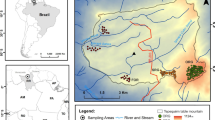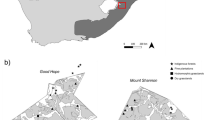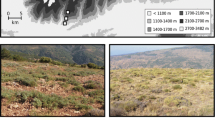Abstract
The ancient landscape of the South - West Australian Floristic Region (SWAFR) is characterized by exceptional floristic diversity, attributed to a complex mosaic of nutrient - impoverished soils. Between - soil type differences in nutrient availability are expected to affect floristic assemblage patterns in the SWAFR. We compared patterns of floristic diversity between open - forest samples from three soil types in the high - rainfall zone of the SWAFR. The importance of environmental and spatial factors for species compositional turnover within soil types were evaluated within canonical correspondence analyses using variation partitioning. Patterns of phylogenetic diversity and dispersion were contrasted between soil types and related to differences in soil nutrient availability. Between - quadrat shared phylogenetic branch length for individual life form categories was correlated with explanatory variables using Mantel tests. Species and phylogenetic diversity increased with a decline in soil nutrients and basal area. Nutrient - poorer soils were differentiated by higher species density and phylogenetic diversity, and larger phylogenetic distances between species. Species turnover was best explained by environmental factors when soil nutrient concentrations and basal area were low. Coastal and inland quadrats from the most fertile soil type were distinguished by significantly differing patterns of phylogenetic diversity. Inland quadrats were characterized by strong relationships between phylogenetic diversity and environment, while phylogenetic patterns remained largely unaccounted for by explanatory variables within coastal quadrats. Phylogenetic diversity was more strongly related with environment within upland landform types for nutrient-poor soils. We highlight the complex relationships between climatic and edaphic factors within the SWAFR, and propose that the occurrence of refugial habitat for plant phylogenetic diversity is dynamically linked with these interactions. Climate change susceptibility was estimated to be especially high for inland locations within the high - rainfall zone. Despite the strong relationship between floristic diversity and soil fertility, holistic conservation approaches are required to conserve the mosaic of soil types regardless of soil nutrient status.








Similar content being viewed by others
Abbreviations
- SWAFR:
-
South - West Australian Floristic Region
- CCA:
-
Canonical Correspondence Analysis
References
Adams JA, Walker TW (1975) Some properties of a chrono-toposequence of soils from granite in New Zealand, 2. forms and amounts of phosphorus. Geoderma 13:41–51
Angiosperm Phylogeny Group (2003) An update of the angiosperm phylogeny group classification for the orders and families of flowering plants:APG II. Bot J Linn Soc 141:399–436
Bond W (2010) Do nutrient-poor soils inhibit development of forests? A nutrient stock analysis. Plant Soil 334:46–60
Borcard D, Legendre P, Drapeau P (1992) Partialling out the spatial component of ecological variation. Ecology 73:1045–1055
Bormann FH, Likens GE (1979) Pattern and process in a forested ecosystem. Springer, New York
Braun-Blanquet J (1932) Plant-Sociology: the study of plant communitites. USA, New York
Bryant JA, Lamanna C, Morlon H, Kerkhoff AJ, Enquist BJ, Green JL (2008) Microbes on mountainsides: contrasting elevational patterns of bacterial and plant diversity. Proc Natl Acad Sci USA 105:11505–11511
Cain S (1939) The climax and its complexities. Am Midl Nat 21:146–181
Cavender-Bares JA, Keen A, Miles B (2006) Phylogenetic structure of Floridian plant communities depends on taxonomic and spatial scale. Ecology 87:S109–S122
Chapin FS (1980) The mineral nutrition of wild plants. Annu Rev Ecol Syst 11:233–260
Churchward HM, McArthur WM, Sewell PL, Bartle GA (1988) Landforms and soils of the south coast and hinterland, W.A. Northcliffe to Many Peaks. 88/1, CSIRO of Water Resources Division
Clark DB, Palmer MW, Clark DA (1999) Edaphic factors and the landscape - scale distributions of tropical rain forest trees. Ecology 80:2662–2675
Coates DJ, Atkins KA (2001) Priority setting and the conservation of Western Australia's diverse and highly endemic flora. Biol Conserv 97:251–263
Coley PD, Bryant JP, Chapin FS (1985) Resource availability and plant antiherbivore defense. Science 230:895–899
Cowles HC (1901) The physiographic ecology of Chicago and vicinity; a study of the origin, development, and classification of plant societies. Bot Gaz 31:73–108
Denton MD, Veneklaas EJ, Freimoser FM, Lambers H (2007) Banksia species (Proteaceae) from severely phosphorus-impoverished soils exhibit extreme efficiency in the use and re-mobilization of phosphorus. Plant Cell Environ 30:1557–1565
Diamond JM (1975) Assembly of species communities. In: Cody KM, Diamond JM (eds) Ecology and evolution of communities. Harvard University Press, Cambridge, pp 342–444
Drury WH (1956) Bog flats and physiographic processes in the upper Kuskokwim River region, Alaska. Contrib. Gray Herbarium, Harvard University
Environment Australia (2000) Revision of the interim biogeographic regionalisation for Australia (IBRA) and development of Version 5.1. Environment Australia, Canberra
Faith DP (1992) Conservation evaluation and phylogenetic diversity. Biol Conserv 61:1–10
Faith DP (2007) Phylogeny and conservation. Syst Biol 56:690–694
Fiedler P (2009) New lessons from ancient history. Plant Soil 322:87–89
Fischer DT, Still CJ, Williams AP (2009) Significance of summer fog and overcast for drought stress and ecological functioning of coastal California endemic plant species. J Biogeogr 36:783–799
Fonseca CR, Overton JM, Collins B, Westoby M (2000) Shifts in trait-combinations along rainfall and phosphorus gradients. J Ecol 88:964–977
Forest F, Grenyer R, Rouget M, Davies TJ, Cowling RM, Faith DP, Balmford A, Manning JC, Proches S, Van Der Bank M, Reeves G, Hedderson TAJ, Savolainen V (2007) Preserving the evolutionary potential of floras in biodiversity hotspots. Nature 445:757–760
Fridley JD (2001) The influence of species diversity on ecosystem productivity: how, where, and why? Oikos 93:514–526
Garten C, Huston M, Thoms CA (1994) Topographic variation of soil nitrogen dynamics at Walker Branch Watershed, Tennessee. For Sci 40:497–512
Gleason HA (1922) The vegetational history of the Middle West. Ann Assoc Am Geogr 12:39–85
Goslee S, Urban DL (2007) The ecodist package for dissimilarity-based analysis of ecological data. J Stat Softw 22:1–19
Grime JP (1973a) Competitive exclusion in herbaceous vegetation. Nature 242:344–347
Grime JP (1973b) Control of species density in herbaceous vegetation. J Environ Manage 1:151–167
Grime JP (1979) Plant strategies and vegetation processes. Wiley-Interscience, John Wiley & Sons, Somerset
Guisan A, Weiss SB, Weiss AD (1999) GLM versus CCA spatial modeling of plant species distribution. Plant Ecol 143:107–122
Hijmans RJ, Cameron SE, Parra JL, Jones PG, Jarvis A (2005) Very high resolution interpolated climate surfaces for global land areas. Int J Climatol 25:1965–1978
Hopper SD (1979) Biogeographical aspects of speciation in the Southwest Australian flora. Annu Rev Ecol Syst 10:399–422
Hopper SD (1992) Patterns of diversity at the population and species levels in south-west Australian mediterranean ecosystems. In: Hobbs RJ (ed) Biodiversity of Mediterranean Ecosystems in Australia. Surrey Beatty & Sons, Chipping Norton, pp 27–46
Hopper SD (2009) OCBIL theory: towards an integrated understanding of the evolution, ecology and conservation of biodiversity on old, climatically buffered, infertile landscapes. Plant Soil 322:49–86
Hopper SD, Gioia P (2004) The Southwest Australian Floristic Region: evolution and conservation of a global hot spot of biodiversity. Annu Rev Ecol Syst 35:623–650
Hooper DU, Chapin FS, Ewel JJ, Hector A, Inchausti P, Lavorel S, Lawton JH, Lodge DM, Loreau M, Naeem S, Schmid B, Setala H, Symstad AJ, Vandermeer J, Wardle D (2005) Effects of biodiversity on ecosystem functioning: a consensus of current knowledge. Ecol Monogr 75:3–35
Horwitz P, Bradshaw D, Hopper SD, Davies P, Froend R, Bradshaw F (2008) Hydrological changes escalates risk of ecosystem stress in Australia's threatened biodiversity hotspot. Proc Roy Soc W Aust 91:1–11
Houlder DJ, Hutchinson MF, Nix HA, McMahon JP (2000) ANUCLIM 5.1 user guide. Centre for Resource and Environmental Studies, Australian National University, Canberra
Huston MA (1979) A general hypothesis of species diversity. Am Nat 113:81–101
Huston MA (1980) Soil nutrients and tree species richness in Costa Rican forests. J Biogeogr 7:147–157
Huston MA (1994) Biological diversity: The coexistence of species on changing landscapes. Cambridge University Press, Cambridge
Huston MA (2003) Understanding the effects of fire and other mortality-causing disturbances on species diversity. In: Burrows NC, Abbott I (eds) Fire in South-Western Australian forests: impacts and management. Backhuys Publishers, Leiden, pp 51–84
Huston MA (2004) Management strategies for plant invasions: manipulating productivity, disturbance, and competition. Divers Distrib 10:167–178
Huston MA, DeAngelis DL (1994) Competition and coexistence: the effects of resource transport and supply rates. Am Nat 144:954–977
Huston MA, Smith T (1987) Plant succession: life history and competition. Am Nat 130:168–198
Kembel SW, Ackerley DD, Blomberg S, Cowan P, Helmus M, Morlon H, Webb CO (2009). Picante - R tools for integrating phylogenies and ecology
Koeppen W (1923) Die Klimate der Erde. Walter de Gruyter, Berlin
Lambers H, Shane MW (2007) Phosphorus nutrition of Australian proteaceae and cyperaceae: a strategy on old landscapes with prolonged oceanically buffered climates. S Afr J Bot 73:274–275
Lambers H, Raven JA, Shaver GR, Smith SE (2008) Plant nutrient-acquisition strategies change with soil age. Trends Ecol Evol 23:95–103
Lambers H, Mougel C, Jaillard B, Hinsinger P (2009) Plant-microbe-soil interactions in the rhizosphere: an evolutionary perspective. Plant Soil 321:83–115
Legendre P (1993) Spatial autocorrelation: trouble or new paradigm? Ecology 74:1659–1673
Leps J, Smilauer P (2003) Multivariate analysis of ecological data using CANOCO. Cambridge University Press, Cambridge
Melillo JM, Aber JD, Muratore JF (1982) Nitrogen and lignin control of hardwood leaf litter decomposition dynamics. Ecology 63:621–626
Michalet R, Rolland C, Joud D, Gafta D, Callaway RM (2003) Associations between canopy and understory species increase along a rainshadow gradient in the Alps: Habitat heterogeneity or facilitation? Plant Ecol 165:145–160
Miller KG, Kominz MA, Browning JV, Wright JD, Mountain GS, Katz ME, Sugarman PJ, Cramer BS, Christie-Blick N, Pekar SF (2005) The Phanerozoic record of global sea-level change. Science 310:1293–1298
Mooney HA (1972) The carbon balance of plants. Annu Rev Ecol Syst 3:315–346
Mucina L, Wardell-Johnson G (2011) Landscape age and soil fertility, climate stability, and fire: a new conceptual framework for evolutionary ecology. Plant Soil. doi:10.1007/s11104-011-0734-x
Myers N, Mittermeier RA, Mittermeier CG, da Fonseca GAB, Kent J (2000) Biodiversity hotspots for conservation priorities. Nature 403:853–858
Odum P (1969) The strategy of ecosystem development. Science 164:262–270
Ohmann JL, Spies TA (1998) Regional gradient analysis and spatial pattern of woody plant communities of Oregon forests. Ecol Monogr 68:151–182
Pastor J, Post W (1986) Influence of climate, soil moisture, and succession on forest carbon and nitrogen cycles. Biogeochemistry 2:3–27
Pate JS, Verboom WH (2009) Contemporary biogenic formation of clay pavements by eucalypts: further support for the phytotarium concept. Ann Bot 103:673–685
Pate JS, Verboom WH, Galloway PD (2001) Co-occurrence of Proteaceae, laterite and related oligotrophic soils: coincidental associations or causative inter-relationships? Aust J Bot 49:529–560
Pausas JG, Verdu M (2008) Fire reduces morphospace occupation in plant communitites. Ecology 89:2181–2186
Poot P, Lambers H (2003) Are trade-offs in allocation pattern and root morphology related to species abundance? A congeneric comparison between rare and common species in the south-western Australian flora. J Ecol 91:58–67
Poot P, Lambers H (2008) Shallow-soil endemics: adaptive advantages and constraints of a specialized root-system morphology. New Phytol 178:371–381
Post WM, Emanuel WR, Zinke PJ, Stangenberger AG (1982) Soil carbon pools and world life zones. Nature 298:156–159
Raven PH, Axelrod DI (1978) Origin and relationships of the California flora. University of California Press, Berkeley
Richardson S, Peltzer D, Allen R, McGlone M, Parfitt R (2004) Rapid development of phosphorus limitation in temperate rainforest along the Franz Josef soil chronosequence. Oecologia 139:267–276
Shane MW, Lambers H (2006) Systemic suppression of cluster-root formation and net P uptake rates in Grevillea crithmifolia at elevated P supply: a proteacean with resistance for developing symptoms of 'P toxicity'. J Exp Bot 57:413–423
Shane MW, Cramer MD, Lambers H (2008) Root of edaphically controlled Proteaceae turnover on the Agulhas Plain, South Africa: phosphate uptake regulation and growth. Plant Cell Environ 31:1825–1833
ter Braak CJF, Smilauer P (2002) Canoco 4.5 reference manual and CanoDraw for Windows user's guide: Software for canonical community ordination, version 4.5. Microcomputer Power, Ithaca
Verboom GA, Dreyer LL, Savolainen V (2009) Understanding the origins and evolution of the world's biodiversity hotspots: the biota of the African 'Cape Floristic Region' as a case study. Mol Phylogenet Evol 51:1–4
Walker LR, del Moral R (2003) Primary succession and ecosystem rehabilitation. Cambridge University Press, Cambridge
Walker J, Reddell P (2007) Retrogressive succession and restoration on old landscapes. In: Walker LR, Walker J, Hobbs RJ (eds) Linking restoration and ecological succession. Springer, New York, pp 69–89
Walker TW, Syers JK (1976) The fate of phosphorus during pedogenesis. Geoderma 15:1–19
Walker J, Thompson CH, Fergus JF, Tunstall BR (1981) Plant succession and soil development in coastal sand dunes of subtropical eastern Australia. In: West DC, Shugart HH, Botkin DB (eds) Forest Succession: Concepts and Applications. Springer, New York, pp 107–131
Wardle DA (2009) Aboveground and belowground consequences of long-term forest retrogression in the timeframe of millennia and beyond. In: Wirth C, Gleixner G, Heimann M, Wardle DA (eds) Old-growth forests. Springer, Berlin, pp 193–209
Wardell-Johnson G, Williams M (1996) A floristic survey of the Tingle Mosaic, south-western Australia. Proc Roy Soc W Aust 79:249–276
Wardell-Johnson G, Horwitz P (2000) The recognition of heterogeneity and restricted endemism in the management of forested ecosystems in south-western Australia. Aust For 63:218–225
Wardle DA, Bardgett RD, Klironomos JN, Setälä H, van der Putten WH, Wall DH (2004) Ecological linkages between aboveground and belowground biota. Science 304:1629–1633
Wardle DA, Bardgett RD, Walker LR, Peltzer DA, Lagerström A (2008) The response of plant diversity to ecosystem retrogression: evidence from contrasting long-term chronosequences. Oikos 117:93–103
Webb CO, Donoghue MJ (2005) Phylomatic:tree retrieval for applied phylogenetics. Mol Ecol Notes 5:181–183
Webb CO, Ackerley DD, Kembel SW (2008) Phylocom: software for the analysis of phylogenetic community structure and character evolution. Bioinformatics 24:2098–2100
Wikstrom N, Savolainen V, Chase MW (2001) Evolution of the angiosperms: calibrating the family tree. Proc R Soc Lond B 268:2211–2220
Yesson C, Culham A (2006) Phyloclimatic modeling: combining phylogenetics and bioclimatic modeling. Syst Biol 55:785–802
Acknowledgements
The project has been funded by an ARC International Linkage Grant LX0775868 to the second author. Funding for the first author has been provided from the Commonwealth Government through an Australian Postgraduate Award. We would like to thank Joselyn Fissioli and Carly Bishop for providing support with the manipulation and formatting of spatial and floristic data from South - Western Australia.
Author information
Authors and Affiliations
Corresponding author
Additional information
Responsible Editor: Jeffrey Walck.
Rights and permissions
About this article
Cite this article
Sander, J., Wardell-Johnson, G. Impacts of soil fertility on species and phylogenetic turnover in the high - rainfall zone of the Southwest Australian global biodiversity hotspot. Plant Soil 345, 103–124 (2011). https://doi.org/10.1007/s11104-011-0763-5
Received:
Accepted:
Published:
Issue Date:
DOI: https://doi.org/10.1007/s11104-011-0763-5




